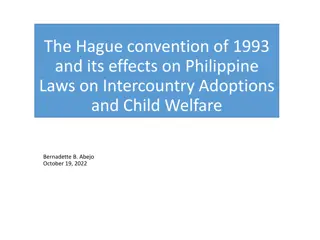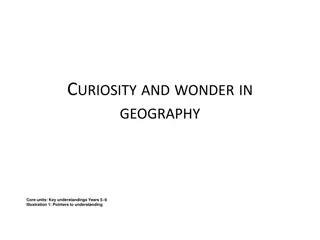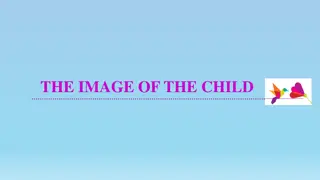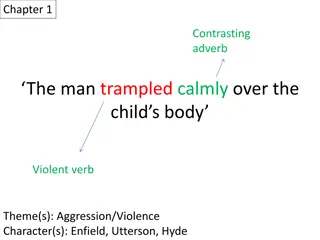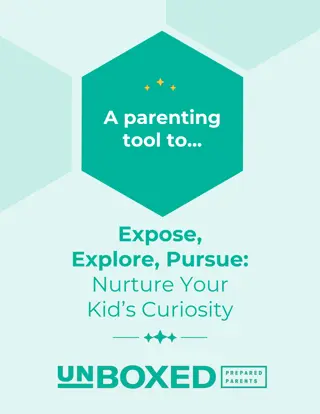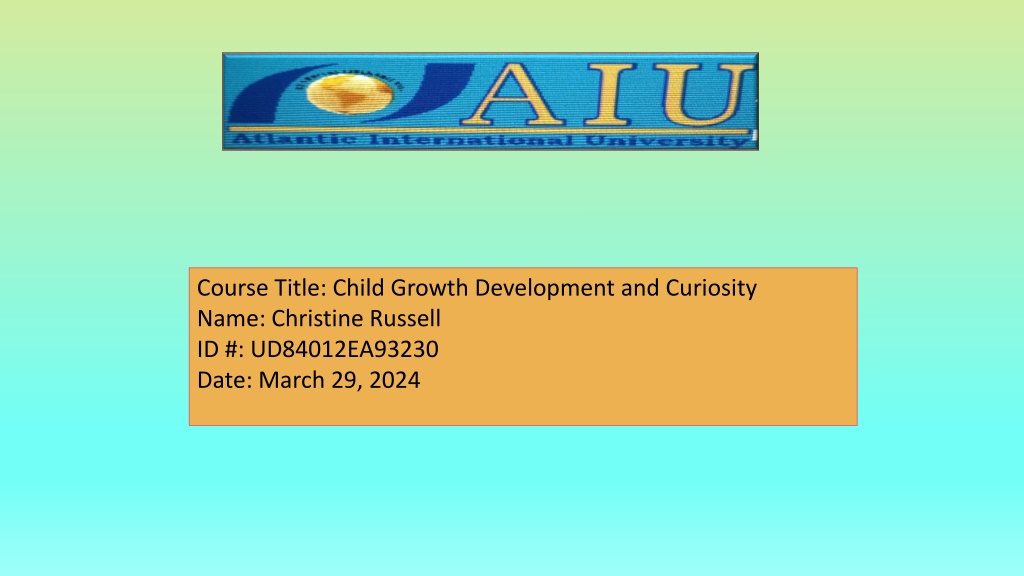
Understanding the Significance of Curiosity in Child Development
Explore the concept of curiosity in child development and its role in fostering cognitive growth through the perspectives of influential theorists like Piaget, Vygotsky, and Dewey. Discover how curiosity drives learning, promotes critical thinking, and fosters creativity in children.
Download Presentation

Please find below an Image/Link to download the presentation.
The content on the website is provided AS IS for your information and personal use only. It may not be sold, licensed, or shared on other websites without obtaining consent from the author. Download presentation by click this link. If you encounter any issues during the download, it is possible that the publisher has removed the file from their server.
E N D
Presentation Transcript
Course Title: Child Growth Development and Curiosity Name: Christine Russell ID #: UD84012EA93230 Date: March 29, 2024
Question 1: Define the concept of curiosity in child development and discuss its significance in fostering cognitive growth. (5 marks) Understanding curiosity in child development involves multiple theoretical perspectives that shed light on its nature, development, and implications for education. Here are some key perspectives along with associated theorists and relevant bibliography:
Introduction Curiosity in child development refers to an innate drive or desire to explore, learn, and understand the world around them. It is characterized by a sense of wonder, questioning, and a willingness to engage in new experiences. Curiosity plays a crucial role in fostering cognitive growth as it drives children to actively seek out knowledge, make connections, and develop various cognitive skills such as problem-solving, critical thinking, and creativity. From a theoretical perspective, several theorists have emphasized the significance of curiosity in child development:
Jean Piaget: Piaget J. (1952). A pioneering psychologist in the field of child development, emphasized the role of curiosity in his theory of cognitive development. He believed that children actively construct their understanding of the world through exploration and experimentation. According to Piaget, curiosity motivates children to engage in activities that help them assimilate new information and accommodate their existing knowledge structures. Stimulates Learning: Curiosity prompts children to ask questions, seek answers, and actively explore their environment, leading to the acquisition of new knowledge and skills.
Lev Vygotsky: Vygotsky, L. S. (1978). Another influential theorist, proposed the concept of the zone of proximal development (ZPD), which refers to the range of tasks that children can perform with the assistance of others. Vygotsky suggested that curiosity drives children to seek out assistance from more knowledgeable individuals, such as parents, teachers, or peers, in order to learn and master new skills within their ZPD. Promotes Critical Thinking: Curiosity encourages children to think critically, evaluate information, and make connections between different concepts, thereby enhancing their problem-solving abilities.
John Dewey: Dewey, J. (1938). An educational philosopher, emphasized the importance of hands- on, experiential learning in fostering curiosity and intellectual growth. He argued that children learn best when they are actively engaged in meaningful activities that capture their interest and curiosity, rather than through passive instruction. Fosters Creativity: Curiosity stimulates imaginative thinking and encourages children to approach problems from novel perspectives, fostering creativity and innovation.
Albert Bandura: Bandura, A. (1977). Bandura's social learning theory highlights the role of observational learning and modeling in shaping children's behavior and cognitive development. Curiosity motivates children to observe and imitate others, leading to the acquisition of new skills and knowledge through social interaction. Supports Emotional Development: Curiosity promotes a sense of autonomy, confidence, and intrinsic motivation, which are essential for healthy emotional development. Enhances Social Skills: Curiosity motivates children to interact with others, share their ideas, and collaborate on projects, leading to the development of communication and social skills.
Summary In summary, curiosity is a fundamental aspect of child development that plays a central role in fostering cognitive growth, facilitating learning, critical thinking, creativity, and social interaction.
Conclusion These theoretical perspectives offer valuable insights into the role of curiosity in child development and its implications for educational practices. By understanding the underlying mechanisms of curiosity, educators can design learning environments that foster exploration, creativity, and intrinsic motivation.
Bibliography Piaget, J. (1952). The Origins of Intelligence in Children. New York: International Universities Press. Vygotsky, L. S. (1978). Mind in Society: The Development of Higher Psychological Processes. Cambridge, MA: Harvard University Press. Dewey, J. (1938). Experience and Education. New York: Macmillan. Bandura, A. (1977). Social Learning Theory. Englewood Cliffs, NJ: Prentice-Hall.
Question 2: Explain the role of intrinsic and extrinsic motivation in shaping children's curiosity. Provide examples to illustrate each type. (6 marks) Introduction Intrinsic and extrinsic motivation play crucial roles in shaping children's curiosity, influencing their engagement in learning activities and exploration of the world around them. Here's an explanation of each type with examples, along with relevant theorists and bibliography:
1. Intrinsic Motivation: Definition: Intrinsic motivation refers to the inner drive or desire to engage in an activity for its own sake, deriving pleasure, satisfaction, or personal fulfillment from the activity itself. Examples: A child who is intrinsically motivated to learn might enjoy reading books simply because they find joy in exploring new ideas and stories. Another example could be a child who is curious about nature and spends time observing insects in the backyard because they genuinely enjoy the process of discovery. Theorists: Deci and Ryan's Self-Determination Theory (SDT) emphasizes intrinsic motivation as being driven by internal rewards such as autonomy, competence, and relatedness.
2. Extrinsic Motivation: Definition: Extrinsic motivation involves engaging in an activity in pursuit of external rewards or to avoid punishment rather than for the inherent enjoyment or satisfaction of the activity itself. Examples: A child might study hard for a test not because they enjoy the subject, but because they want to earn a good grade and praise from their parents or teachers. Another example could be a child participating in a science fair to win a trophy or recognition. Theorists: B.F. Skinner's Behaviorism theory emphasizes the role of external rewards and reinforcements in shaping behavior. Albert Bandura's Social Learning Theory also discusses how external factors such as rewards and punishments influence motivation and behavior.
Summary By understanding both intrinsic and extrinsic motivation, educators and parents can create environments that foster children's natural curiosity while also providing appropriate external incentives when needed. Encouraging intrinsic motivation can lead to more sustained and genuine curiosity-driven exploration, while judicious use of extrinsic motivators can help scaffold learning experiences and maintain engagement when necessary.
Conclusion In humans, intrinsic motivation is not the only form of motivation activity, but it is a important and pervasive one. From birth onward, humans, in their healthiest states, are active, inquisitive, curious, and playful creatures, displaying a ubiquitous readiness to learn and explore, and they do not require extraneous incentives to do so. This natural motivational tendency is a critical element in cognitive, social, and physical development because it is through acting on one s inherent interests that one grows in knowledge and skills. The inclinations to take interest in novelty, to actively assimilate, and to creatively apply our skills is not limited to childhood, but is a significant feature of human nature that affects performance and persistence.
Bibliography Deci, E. L., & Ryan, R. M. (1985). Intrinsic motivation and self determination in human behavior. Springer Science & Business Media. Skinner, B. F. (1971). Beyond freedom and dignity. Hackett Publishing. Bandura, A. (1977). Social learning theory. Prentice Hall.
Question 3: Discuss how socio-cultural factors influence the development of curiosity in children. Include specific cultural practices or norms that either encourage or inhibit curiosity. (7 marks) Introduction The development of curiosity in children is heavily influenced by socio-cultural factors, encompassing various cultural practices, norms, and societal values. Several theorists have explored the role of socio-cultural factors in shaping curiosity in children. Here, I'll discuss some of these factors and theorists along with relevant bibliography:
1. Cultural Context and Beliefs: Different cultures have varying beliefs about the role of curiosity in child development. For example, in cultures that prioritize conformity and obedience, curiosity might be discouraged, as it can be seen as disruptive or disrespectful. Conversely, in cultures that value exploration and learning, curiosity might be encouraged and nurtured. Theorist: Lev Vygotsky's sociocultural theory emphasizes the importance of cultural context in shaping cognitive development. He argued that children learn through social interactions within their cultural environment, and their curiosity is influenced by the cultural norms and values that surround them.
2. Parenting Styles: Parenting practices play a crucial role in either fostering or inhibiting curiosity in children. Authoritarian parenting, characterized by strict rules and little encouragement for questioning, may suppress curiosity. In contrast, authoritative parenting, which combines warmth and support with reasonable demands and expectations, tends to promote curiosity and autonomy. Theorist: Diana Baumrind's research on parenting styles has been influential in understanding how different approaches impact child development, including curiosity.
3.Educational Practices: School environments can significantly shape children's curiosity. Curiosity is more likely to flourish in educational settings that promote inquiry-based learning, encourage exploration, and provide opportunities for autonomy. Conversely, rigid educational systems that emphasize rote memorization and standardized testing may stifle curiosity. Theorist: John Dewey's progressive education philosophy emphasizes hands-on, experiential learning and the importance of curiosity in driving learning.
4. Cultural Narratives and Role Models: Cultural narratives, stories, and role models can inspire curiosity in children by showcasing the value of exploration, discovery, and learning. Cultures that celebrate curiosity through folklore, literature, and media may cultivate a more curious mindset in children. Theorist: Albert Bandura's social learning theory highlights the importance of observational learning and role models in shaping behavior.
Conclusion In conclusion, socio-cultural factors play a pivotal role in shaping the development of curiosity in children. Understanding these factors can inform efforts to create environments that nurture curiosity and support children's natural inclination to explore, learn, and discover.
Bibliography Vygotsky, L. S. (1978). Mind in society: The development of higher psychological processes. Harvard University Press. Baumrind, D. (1991). The influence of parenting style on adolescent competence and substance use. Journal of Early Adolescence, 11(1), 56-95. Dewey, J. (1916). Democracy and education: An introduction to the philosophy of education. Macmillan. Bandura, A. (1977). Social learning theory. Prentice-Hall.
Question 4: Evaluate the impact of technology on children's curiosity and cognitive development. Provide arguments for both positive and negative effects, supported by relevant research findings. (8 marks) Introduction The impact of technology on children's curiosity and cognitive development is a complex and multifaceted issue, with both positive and negative effects. Let's examine arguments for both sides, supported by relevant research findings and the perspectives of notable theorists.
Positive Effects: 1. Access to Information: Technology provides children with access to a vast amount of information, allowing them to satisfy their curiosity about various topics. This exposure to information can broaden their horizons and stimulate curiosity. Jean Piaget's theory of cognitive development emphasizes the importance of exploration and interaction with the environment in children's learning processes.
2. Interactive Learning Tools: Educational apps, games, and software are designed to engage children in interactive learning experiences, fostering their curiosity and cognitive development. Lev Vygotsky's sociocultural theory highlights the role of social interaction and cultural tools, including technology, in cognitive development.
3. Enhanced Problem-Solving Skills: Technology-based activities often require children to think critically and solve problems, which can enhance their cognitive skills. Seymour Papert's constructionist theory posits that children learn best when actively engaged in constructing things in the world.
4. Creativity and Innovation: Technology can inspire creativity and innovation in children through activities such as coding, digital art, and multimedia creation. This can stimulate curiosity and encourage exploration of new ideas and concepts. Howard Gardner's theory of multiple intelligences suggests that children have diverse strengths and abilities, which can be nurtured through various forms of expression, including technology- mediated ones.
Negative Effects: 1. Reduced Attention Span: Excessive use of technology, particularly passive consumption of media, has been associated with shortened attention spans in children. Constant exposure to quick-paced digital content may hinder their ability to focus for extended periods, impacting their cognitive development negatively. Sherry Turkle, a psychologist and author, has highlighted concerns about technology's role in diminishing attention spans.
2. Social Isolation: Excessive screen time can lead to social isolation, as children may spend less time interacting face-to- face with peers and family members. This lack of social interaction can impede their social and emotional development. Erik Erikson's psychosocial theory emphasizes the importance of social interactions in shaping children's sense of self and identity.
3. Risk of Addiction: Some children may become addicted to technology, particularly to video games and social media, which can interfere with other aspects of their lives, including academic performance and physical health. Addiction theorists like Kimberly Young have extensively studied and documented the phenomenon of internet and technology addiction among children and adolescents.
4. Limited Physical Activity: Excessive screen time is often associated with sedentary behavior, leading to a decline in physical activity levels among children. This can have adverse effects on their physical health and overall well-being, impacting cognitive development indirectly. The American Academy of Pediatrics and other health organizations recommend limiting screen time to promote physical activity and healthy development in children.
Conclusion These arguments and theorists provide a comprehensive overview of the potential impact of technology on children's curiosity and cognitive development, highlighting both the positive opportunities and negative consequences that technology presents. It's essential for parents, educators, and policymakers to consider these factors and strive for a balanced approach to technology use in children's lives.
Bibliography Piaget, J. (1952). The origins of intelligence in children. New York: International Universities Press. Vygotsky, L. S. (1978). Mind in society: The development of higher psychological processes. Harvard University Press. Papert, S. (1980). Mindstorms: Children, computers, and powerful ideas. Basic Books. Gardner, H. (1983). Frames of mind: The theory of multiple intelligences. Basic Books.
Turkle, S. (2011). Alone together: Why we expect more from technology and less from each other. Basic Books. Erikson, E. H. (1993). Childhood and society. WW Norton & Company. Young, K. S. (1999). Internet addiction: Symptoms, evaluation, and treatment. Innovations in Clinical Practice: A Source Book, Vol. 17, 19-31.
Question 5: Compare and contrast the developmental trajectories of curiosity in early childhood, middle childhood, and adolescence. Highlight key differences and similarities, and explain how educators can support curiosity across these stages. (9 marks) Introduction Certainly! Understanding the developmental trajectories of curiosity across early childhood, middle childhood, and adolescence can provide valuable insights for educators to support children and adolescents in their learning journey. Here's a comparison and contrast of these trajectories along with ways educators can foster curiosity at each stage:
Early Childhood (Ages 3-6): Developmental Characteristics: 1. Exploration and Wonder: Curiosity in early childhood is marked by a natural inclination towards exploration and wonder. Children are eager to learn about their surroundings, asking countless questions and showing interest in novel experiences. Key Educator Strategies: Encourage Exploration: Provide opportunities for hands-on exploration through sensory activities, nature walks, and open-ended materials.
Developmental Characteristics: 2. Concrete Exploration: Curiosity tends to be focused on tangible objects and experiences in the immediate environment. Children may engage in hands-on activities to satisfy their curiosity. Key Educator Strategies: Foster a Safe Environment: Create a safe and supportive atmosphere where children feel comfortable asking questions and expressing their curiosity without fear of judgment.
Developmental Characteristics: 3. Imagination and Pretend Play: Imaginative play serves as a significant outlet for curiosity, allowing children to experiment with different roles and scenarios. Key Educator Strategies: Engage in Scaffolding: Offer guidance and support as children explore new concepts, helping them make connections between their experiences and knowledge.
Middle Childhood (Ages 6-12): Developmental Characteristics: 1. Increasing Cognitive Development: Curiosity becomes more sophisticated as children's cognitive abilities develop. They begin to ask more complex questions and seek deeper understanding. Key Educator Strategies: Promote Inquiry-Based Learning: Encourage inquiry-based approaches where children can investigate topics of interest through research, experimentation, and critical thinking.
2. Growing Social Awareness: Curiosity extends beyond the immediate environment to include an interest in social dynamics, cultural differences, and abstract concepts. 3. Formation of Interests: Children start to develop specific interests and hobbies, driving their curiosity towards particular topics or activities. Key Educator Strategies: Provide Diverse Learning Opportunities: Offer a variety of resources and experiences to cater to different interests and learning styles, fostering a sense of autonomy and choice. Support Peer Collaboration: Facilitate group discussions, collaborative projects, and peer interactions to encourage sharing of ideas and perspectives, sparking curiosity through social engagement.
Adolescence (Ages 12-18): Developmental Characteristics: 1. Identity Exploration: Curiosity during adolescence often revolves around self-discovery, identity formation, and future aspirations. Adolescents may question societal norms, explore personal values, and contemplate their place in the world. Key Educator Strategies: Encourage Critical Reflection: Facilitate discussions on complex issues, encouraging adolescents to critically reflect on diverse perspectives and challenge assumptions.
2. Abstract Thinking: With further cognitive development, adolescents are capable of abstract thinking and hypothetical reasoning, leading to curiosity about philosophical, ethical, and existential questions. Key Educator Strategies: Provide Mentorship and Guidance: Offer mentorship opportunities, career exploration programs, and guidance counseling to support adolescents in their journey of self-discovery and goal-setting.
3. Risk-Taking and Novel Experiences: Adolescents may seek out novel experiences and take risks as they explore their identities and boundaries. Key Educator Strategies: Promote Civic Engagement: Encourage involvement in community service, activism, and leadership roles, fostering a sense of agency and purpose beyond oneself.
How Educators Can Support Curiosity Across Stages: 1. Create a Nurturing Environment: Establish a supportive classroom environment where curiosity is valued, and students feel encouraged to ask questions and explore new ideas. 2. Personalize Learning Experiences: Tailor instruction to accommodate individual interests, abilities, and learning styles, allowing students to pursue their curiosity in meaningful ways.
3. Embrace Failure and Iteration: Encourage a growth mindset by celebrating mistakes as opportunities for learning and growth, fostering resilience and perseverance in the face of challenges. 4. Model Curiosity: Demonstrate curiosity yourself by sharing your own interests, questions, and discoveries with students, serving as a role model for lifelong learning.
Conclusion By integrating insights from theorists and understanding the unique developmental characteristics of each stage, educators can effectively support and nurture curiosity across childhood and adolescence, laying the foundation for a lifelong love of learning.







